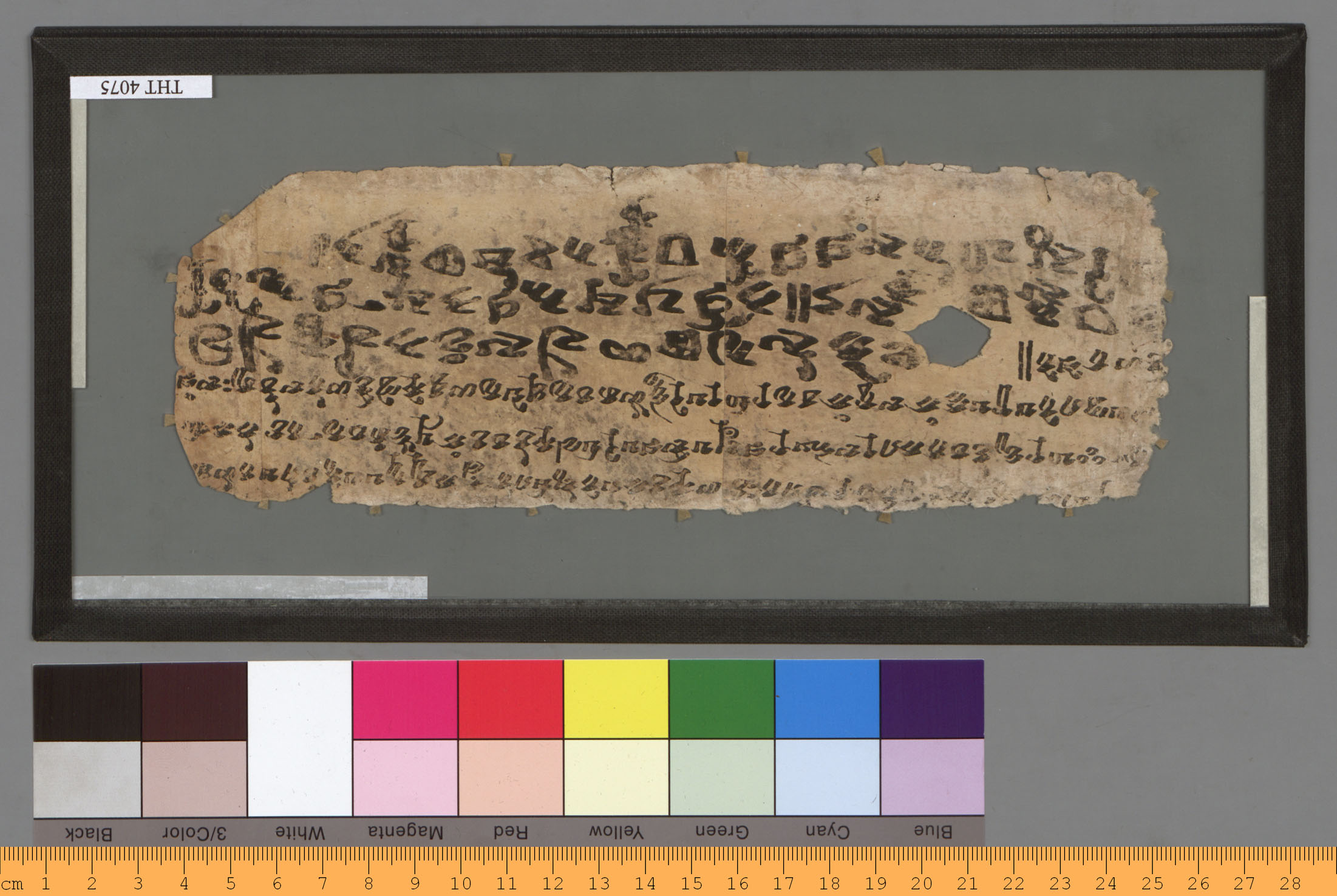Work in progress
THT 4075
| Known as: | THT 4075; SHT 146 |
|---|
| Cite this page as: | Melanie Malzahn. "THT 4075". In A Comprehensive Edition of Tocharian Manuscripts (CEToM). Created and maintained by Melanie Malzahn, Martin Braun, Hannes A. Fellner, and Bernhard Koller. https://cetom.univie.ac.at/?m-tht4075 (accessed 30 Jun. 2025). |
|---|
Edition |
| Editor: | Melanie Malzahn |
|---|
| Date of online publication: | 2014-09-10 |
|---|
Provenience |
| Main find spot: | Kizil Ming-öy |
|---|
| Specific find spot: | Rothkuppelraum |
|---|
| Expedition code: | T III MQR B 26 |
|---|
| Collection: | Berlin Turfan Collection |
|---|
Language and Script |
| Language: | Skt.; TB |
|---|
| Linguistic stage: | late |
|---|
| Add. linguistic characteristics: | hypercorrect |
|---|
| Script: | classical |
|---|
Text contents |
| Text genre: | Literary |
|---|
| Text subgenre: | Medicine/Magic |
|---|
| Verse/Prose: | prose |
|---|
Object |
| Manuscript: | Pustaka |
|---|
| Material: |
ink
on paper |
|---|
| Form: | Poṭhī |
|---|
| Size (h × w): | 7.5 × 21 cm |
|---|
| Number of lines: | 6 |
|---|
Images
Transliteration
| b4 | ○ [wa] rni se tya ma s̝a le sa rwa na li kṣa le o |
|---|
| b5 | pa tsa ma ske dra || na mo pra su nna ma na sa • ma [n]da [v]i [r]o |
|---|
| b6 | ri sva ha te sa ma ma nto pa l[sk]o ta ka rṣe ma ske tra • |
|---|
Transcription
| * | namo prasunnamanasa • mandaviro¬ |
|---|
| b6 | rin5n6n7 svaha |
|---|
Translation
| b4 | On water a spell is to be cast. The face is to be washed. She |
|---|
| b5 | becomes not jealous (?). Sanskrit |
|---|
| b6 | Sanskrit Thereby one who is evil-minded becomes friendly. |
|---|
Commentary
Linguistic commentary
| * | The short text shows late/colloquial forms as well as wrong orthography: |
|---|
| n1 | sarwana for särwāna; |
|---|
| n4 | Skt. prasunna- stands for correct Skt. prasanna- ‘clear, friendly’, and °manasa for genitival °manasaḥ, visarga being usually omitted in texts from Eastern Turkestan; note also the use of the genitive instead of the expected dative. |
|---|
| n5 | mäsketra with 3.sg. ending -ra but in addition the kind of hypercorrect spelling with d in mäskedra. |
|---|
| n6 | mamanto-pälsko shows late diphthongization; the form seems to be a bahuvrihi compound consisting of the PPt mamāntau ‘being evil’ and of palsko ‘mind, spirit’. Note further that the Sanskrit is also corrupt, which is often the case in this pustaka (cf. Sander 1994), esp. with respect to wrong vowels. |
|---|
| n7 | svaha for Skt. svāhā ‘hail!’. |
|---|
Remarks
| * | The Tocharian text has been written on the blank space after a Sanskrit donor text (ed. in Waldschmidt and et al. 1965: 83 as no. SHT 146) by a different hand with a brush; the script is very clumsy. The leaf comes from the only complete Sanskrit pustaka book unearthed from Qizil, see Sander 1994: 98; THT 295 and the wooden covers m-tht3990 and m-tht3990b belong to the same pustaka. |
|---|
Philological commentary
| n2 | For the use of the cross-barred square sign to render ‹mä›, see Malzahn 2007a: 287. |
|---|
| n3 | In contrast to Malzahn 2007b: 301, opätsa rather seems to be a complete form; Adams 2013a: 122 connects it with TA 'jealousy' and suggests a privative adjective 'not jealous'. |
|---|
References
Online access
IDP: THT 4075
Edition
Waldschmidt and et al. 1965: 83; Malzahn 2007b: 301-301
Bibliography
Adams 2013a
Adams, Douglas Q. 2013a. A dictionary of Tocharian B. Revised and greatly enlarged. 2nd ed. 2 vols. Amsterdam/New York: Rodopi.
IDP
“The International Dunhuang Project: The Silk Road Online.” n.d. http://idp.bl.uk.
Malzahn 2007a
Malzahn, Melanie. 2007a. “The most archaic manuscripts of Tocharian B and the varieties of the Tocharian B language.” In Instrumenta Tocharica, edited by Melanie Malzahn, 255–97. Heidelberg: Winter.
Malzahn 2007b
Malzahn, Melanie. 2007b. “A preliminary survey of the Tocharian glosses in the Berlin Turfan Collection.” In Instrumenta Tocharica, edited by Melanie Malzahn, 301–19. Heidelberg: Winter.
Sander 1994
Sander, Lore. 1994. “Tocharische Dokumente im Museum für Indische Kunst, Berlin.” In Tocharisch. Akten der Fachtagung der Indogermanischen Gesellschaft, Berlin, September 1990, edited by Bernfried Schlerath, 4:93–104d. TIES Suppl. Reykjavík: Málvísindastofnun Háskóla Íslands.
Waldschmidt and et al. 1965
Waldschmidt, Ernst, and et al. 1965. Sanskrithandschriften aus den Turfanfunden. Teil 1. Die Katalognummern 1–801. Unter Mitarbeit von Walter Clawiter und Lore Holzmann. Vol. 1. Verzeichnis der orientalischen Handschriften in Deutschland 10. Wiesbaden: Franz Steiner Verlag.




